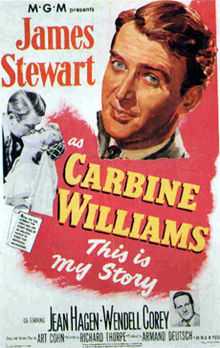Carbine Williams
| Carbine Williams | |
|---|---|
 | |
| Directed by | Richard Thorpe |
| Produced by | Armand Deutsch |
| Written by | Art Cohn |
| Starring | James Stewart |
| Music by | Conrad Salinger |
| Cinematography | William C. Mellor |
| Editing by | Newell P. Kimlin |
| Distributed by | Metro-Goldwyn-Mayer |
| Release dates | May 1952 |
| Running time | 92 minutes |
| Country | United States |
| Language | English |
| Budget | $1,111,000[1] |
| Box office | $2,589,000[1] |
Carbine Williams is a 1952 American drama film directed by Richard Thorpe and starring James Stewart. The film follows the life of its namesake, David Marshall Williams, who invented the operating principle for the M1 Carbine while in a North Carolina prison. The M1 Carbine was used extensively during World War II.
Originally filmed in black-and-white, it is also shown in a computer colorized version.[2]
Plot
The film follows the life of David Marshall Williams (James Stewart), who was a member of the Winchester team that invented the semi-automatic M1 Carbine used in World War II. Williams was found distilling illegal moonshine, and was held responsible for the death of a federal officer during a raid on his still. He was sentenced to thirty years hard labor. He cycled through the prison system, until a firm, but compassionate warden, H.T. Peoples (Wendell Corey) allowed him to work in a prison tool shop. There he invented the gas system for his famous rifle, and eventually was released from prison in 1929 and worked with Winchester Firearms on development of the M1 Carbine.
Cast
- James Stewart as David Marshall 'Marsh' Williams
- Jean Hagen as Maggie Williams
- Wendell Corey as Capt. H. T. Peoples
- Carl Benton Reid as Claude Williams
- John Smith as David Marshall's brother (uncredited)
Reception
According to MGM records the film earned $1,787,000 in the US and Canada [3] and $802,000 elsewhere, resulting in a profit of $575,000.[1]
References
External links
- Carbine Williams at the Internet Movie Database
- Carbine Williams at allmovie
- Carbine Williams at the TCM Movie Database